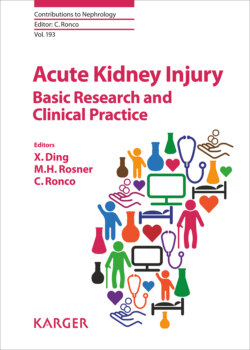Читать книгу Acute Kidney Injury - Basic Research and Clinical Practice - Группа авторов - Страница 18
На сайте Литреса книга снята с продажи.
AKI Definition and Classification in Children and Neonates
ОглавлениеIn 2007, the RIFLE criteria were adapted for use in children (pediatric RIFLE or pRIFLE) [31] (Table 1). In that pivotal study, the essential modifications to the original RIFLE criteria were the introduction of percentage decrease of estimated CrCl based on Schwartz formula (instead of change of absolute creatinine levels/GFR) and slightly modified UO criteria in order to meet the pediatric low changes of creatinine levels and different UO flows. Despite the relatively low number of enrolled children (n = 150), extensive information was already described by this observation: the majority of pediatric AKI (pAKI) episodes occurred in the first ICU admission week and the incidence was very high (up to 80%). About one third of patients attained the pAKI diagnosis by both UO and SCr, whereas the remaining patients only achieved 1 of the 2 criteria (including 18% by UO criteria and 47% by SCr). PAKI was associated with the length of stay in the hospital and ICU. Worse pRIFLE class I or F, after adjustment for severity of illness score, was associated with a significantly increased risk of mortality. All these results were further validated in several studies. In 2015, data from more than 14,000 hospitalized children were analyzed [32] and pAKI diagnosis according to pRIFLE, AKIN, and KDIGO criteria were reported. AKI incidences across the cohort according to pRIFLE, AKIN, and KDIGO were 51.1%, 37.3%, and 40.3%: pRIFLE showed the highest sensitivity (especially in detection of class R patients) and AKIN was the most specific in the most severe class. Mortality was increased in AKI children according to all definitions (pRIFLE, 2.3%; AKIN, 2.7%; KDIGO, 2.5%; versus no AKI [0.8–1.0%]). Even if the clinical relevance of definitions differences in diagnosing and staging of AKI is unclear, there currently is a general consensus to apply KDIGO classification for pAKI. Under these premises, the recent Assessment of Worldwide AKI and Renal angina Epidemiology trial was conducted on more than 4,000 patients (see chapter on pAKI) [33].
A slightly different pathway has been covered by the neonatal AKI (nAKI) definition. In this peculiar population, renal physiology may significantly vary with respect to older patients and the application of pRIFLE or KDIGO may lead to inadequate staging. Problems in the diagnosis of AKI in neonatal ICUs are essentially related to the difficulty on achieving a daily creatinine measurement (due to blood sparing), the uncertainty on normal creatinine levels (mostly influenced by maternal creatinine), variable GFR (secondarily to “immature” kidney function, especially in preterm babies) and, consequently, the absence of baseline/reference values [34]. Furthermore, the need for exactly timed diaper weight is needed to measure UO in case the bladder catheter is not in place. Finally, the pRIFLE urinary criteria appear significantly restrictive because newborn and premature urine flow has to be considered normal only when higher than 1.5 mL/kg/h. The reason for this finding might be identified in the increased neonatal body water content and in the immature tubular development that imply a normally high urine flow in the first days of life. For the same reason, with different conclusions, Koralkar et al. [35] proposed to define nAKI exclusively by creatinine criteria, applying a slight modification of the AKIN stage 3. However, the rate of creatinine decline in the first days of life should also be taken into account in order to adequately appreciate how the renal function of the baby is coping with excess maternal creatinine [36]. With the attempt of reconciling all these controversies, an nAKI workgroup on behalf of the National Institute of Diabetes and Digestive and Kidney Diseases recently proposed a definitive nAKI classification (Table 1) [37]. This definition differs from KDIGO in 3 essential points: (1) UO is recorded every 24 h rather than every 6–12 h because most neonatal ICUs do not report on an hourly diuresis. (2) In order to classify a patient with SCr-AKI, each measurement is compared with the lowest previous measurement to detect both an absolute and a percentage rise from “baseline.” This modification is required because serum creatinine values normally decline over the first weeks after birth, such that the baseline value is constantly changing. (3) Stage 3 is reached when a serum creatinine cutoff of 2.5 mg/dL (221 µmol/L), rather than 4.0 mg/dL (353.6 µmol/L) is reached, since a GFR of <10 mL/min/1.73 m2 is calculated in a neonate with such a SCr concentration. The validation of this classification was recently published in a multicentric observational trial, the Assessment of Worldwide Acute Kidney Injury Epidemiology in Neonates, conducted on more than 2,000 neonates [38] (see the pAKI chapter).
